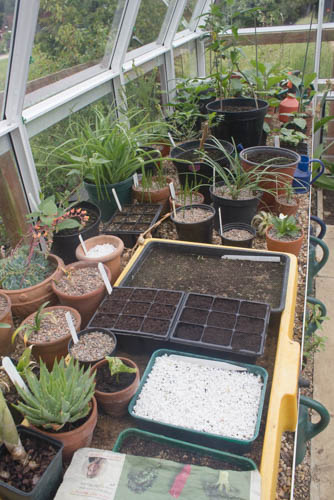
In June there is plenty to do. Aubergines, peppers and chillies should be transplanted as they grow into pots one or two sizes larger when there is a good root system but before they become pot bound, finally transplanting into 23 cm pots or two per growing bag. You can instinctively tell by the size of the plant but if you are not sure, knocking it from the pot to check the condition of the root system. Keep a bucket or bag of compost in the greenhouse so it is warm when needed. Pinch out the tips from the main stems of aubergines when they are 30-40cm tall. Stake or tie into supports as necessary. Aubergines are ‘buzz pollinated’ waiting until the wings of the bee reach the correct frequency before releasing the pollen, so like tomatoes, they can be pollinated by tapping the flowers, ideally when the pollen is dry on a bright sunny day. Only allow five or six aubergines to form, spacing them evenly on each plant, then, remove further flowers.
Peppers and Chilli’s should be transplanted until they are in 23cm pots, pinching out the growing tip when they are about 15cm high encourages branching heavier cropping.
It is still not too late to sow sweetcorn. Use deep pots or recycled drinking cups with a drainage hole in the base. In cooler climates or other locations for rapid germination, (particularly during the current spell of erratic weather) sow French and runner beans in root trainers and pumpkins in individual pots.
Ventilate the greenhouse on hot days but avoid chilling drafts (the incessant easterly winds have been blowing here for weeks). Open the ventilation on the lee ward side of the greenhouse.
Now your greenhouse tomatoes are growing steadily, remove the side shoots of ‘cordon’ varieties to form a single productive stem by snapping them off between your finger and thumb. Tie in tomatoes into canes or string as they grow.
Keep your crops well-watered, using tepid water. Pay particular attention to crops in growing bags, the relatively small plant to compost ratio means they can dry out rapidly. This is particularly important with tomatoes. Erratic watering, so the compost fluctuates from wet to over dry, causes calcium deficiency showing as ‘blossom end rot’ later in the season, when the end of the fruit furthest away from the stem turns black. Although they don’t look attractive, tomatoes suffering from ‘blossom end rot’ are still edible, just slice off the blackened end.
Feed plants in pots regularly. Use general liquid fertiliser initially, then change to high potash tomato fertiliser once the plants are established.
Check plants daily for whitefly and red spider mite, particularly aubergines and keep benches and beds weed free.
‘Harden off’ tender plants once the danger of frost has passed and night temperatures are warmer. Pot them on if necessary. I currently have Ipomoea alba, a white flowered, fragrant ‘Morning Glory’ and Cleome hassleriana ‘Violet Queen’ waiting to be transplanted into a sheltered sunny spot once the weather settles down.
Happy gardening. Matt.


